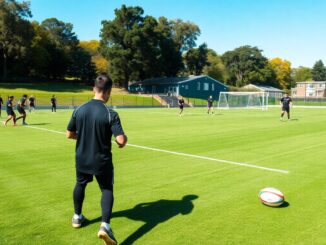What’s next for professional rugby in Wales as teams face tough decisions?

Topics covered
Recent discussions among the Welsh Rugby Union (WRU) and its professional clubs have shed light on the significant challenges that lie ahead for rugby in Wales. As the landscape evolves, a crucial question emerges: can the current setup of four professional teams really be sustained? With financial pressures escalating and strategic discussions in motion, the reality is becoming increasingly apparent.
The State of Professional Rugby in Wales
The WRU recently gathered with representatives from clubs like Cardiff, Dragons, Ospreys, and Scarlets to discuss the future direction of professional rugby. While no definitive agreements came out of the meeting, the talks have laid the groundwork for decisions that could reshape the sport in Wales.
The union aims to work together with these clubs to forge a viable future, but there’s a growing acknowledgment that maintaining four teams might not be realistic—especially under a tiered funding model.
Many in the rugby community are starting to lean towards a more streamlined approach, which could mean reducing the number of professional teams to three or even two.
This shift raises important questions about the sustainability of the current model and what it means for club identity and fan engagement. How do we balance financial viability with the rich history of Welsh rugby?
Analyzing the Financial Landscape
To truly grasp the financial realities, we need to look at key metrics such as churn rate, customer acquisition cost (CAC), and lifetime value (LTV) of the teams’ fanbases. The reluctance of the Ospreys and Scarlets to engage with the proposed funding agreement highlights deeper concerns regarding the WRU’s intentions. If Cardiff were to become a ‘super region’, it could throw the competitive balance and financial health of the other clubs into disarray.
The WRU has outlined three potential paths forward: keeping four teams, slimming down to three, or consolidating to just two. Each option has significant implications for funding distribution and operational sustainability. Opting for a tiered funding model where two clubs receive substantially more financial support might offer a short-term fix, but it fails to tackle the underlying issues of revenue generation and fan engagement necessary for a thriving rugby ecosystem.
Lessons from Failures in Sports Management
Drawing from my experience with startups, I’ve seen too many organizations stumble due to a lack of clear product-market fit (PMF). In professional sports, particularly rugby, this means truly understanding the needs and desires of the fanbase. Ignoring the evolving landscape can lead not just to stagnation but to outright collapse.
For instance, I’ve witnessed startups lose their footing because they didn’t listen to their customers. The same holds true for rugby clubs; if they fail to engage with their supporters and adapt to their expectations, they risk alienating a crucial segment of their audience. It’s vital for clubs to innovate how they connect with fans. This goes beyond enhancing the matchday experience—leveraging digital platforms to maintain that connection year-round is equally important.
Actionable Takeaways for Stakeholders
For founders and decision-makers in the rugby sector, the lessons are crystal clear. First, focus on understanding the financial and emotional investments from your stakeholders—fans, players, and sponsors alike. Second, think about the long-term implications of any structural changes; aim for decisions that promote sustainability rather than quick fixes. Finally, prioritize transparent communication throughout the organization and with the public to build trust and engagement.
As the WRU navigates these turbulent waters, the path ahead will demand a mix of strategic foresight, financial savvy, and a genuine commitment to the sport and its community. The future of Welsh rugby stands at a crossroads, and how it responds now will shape its trajectory for years to come.




